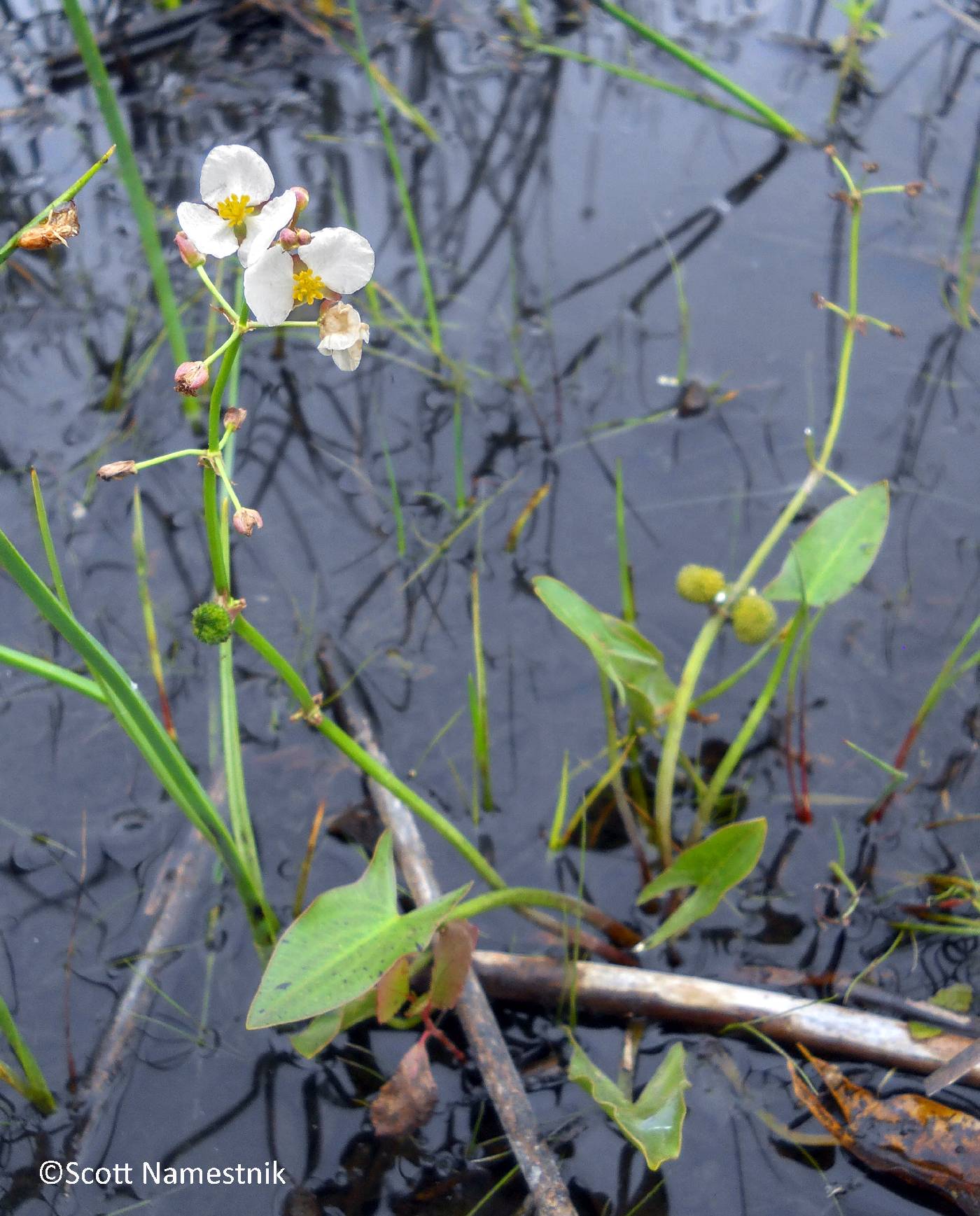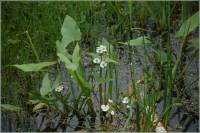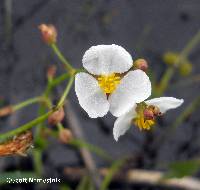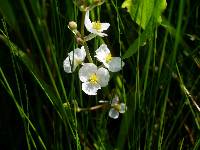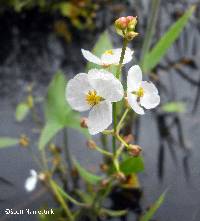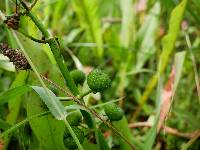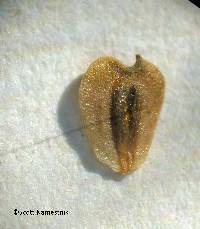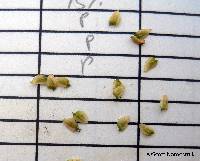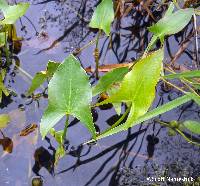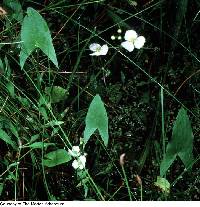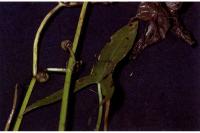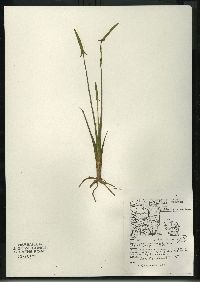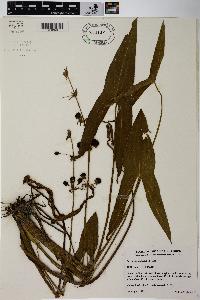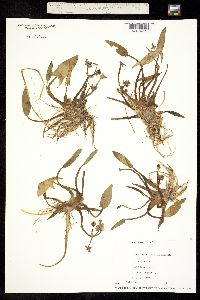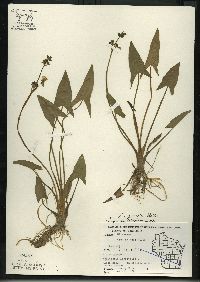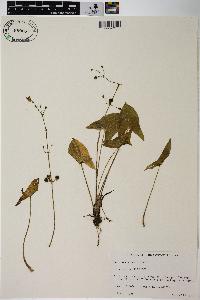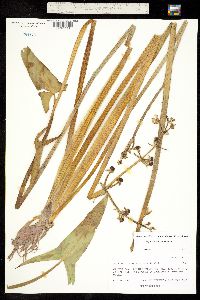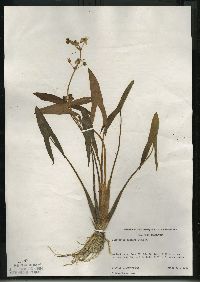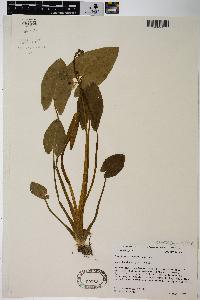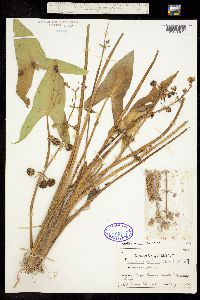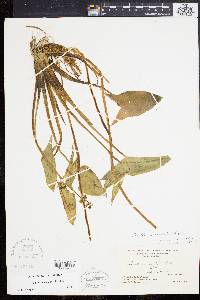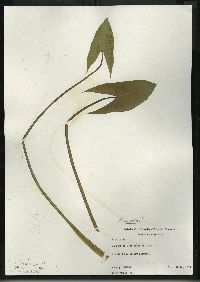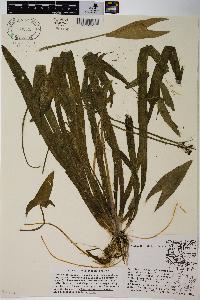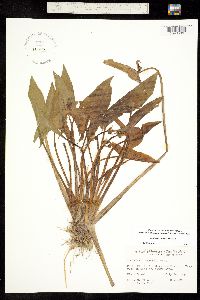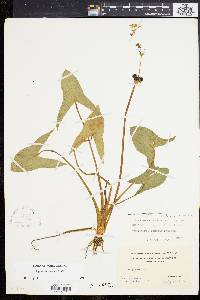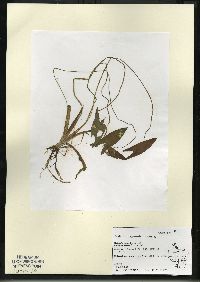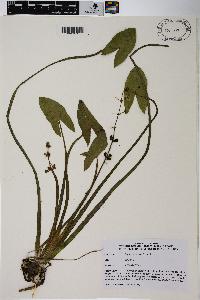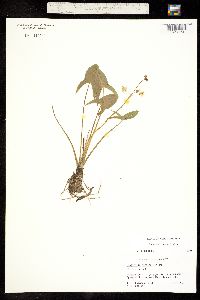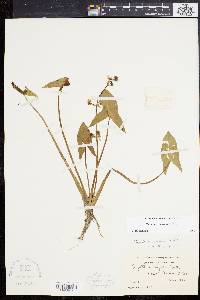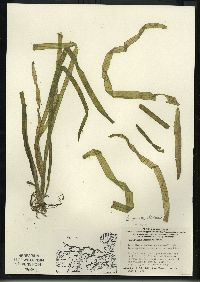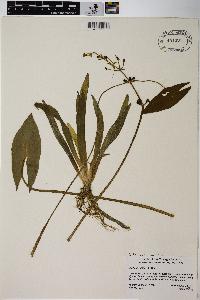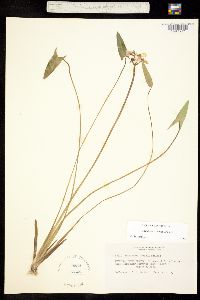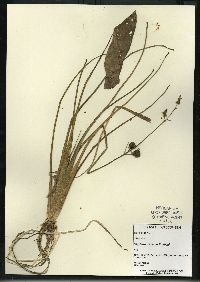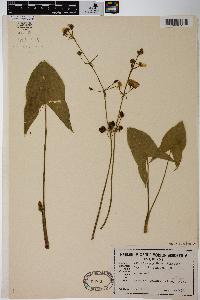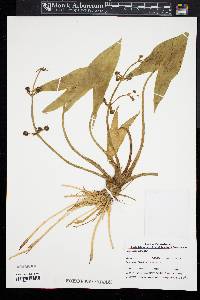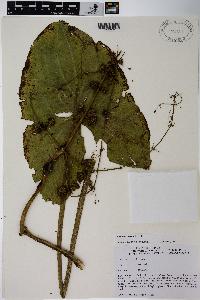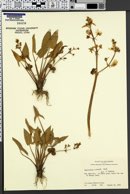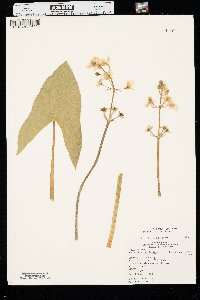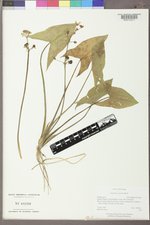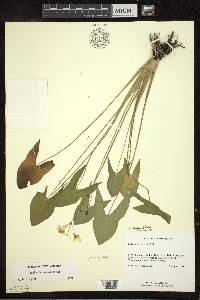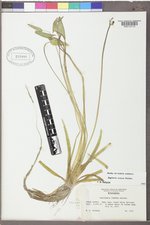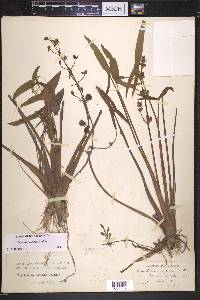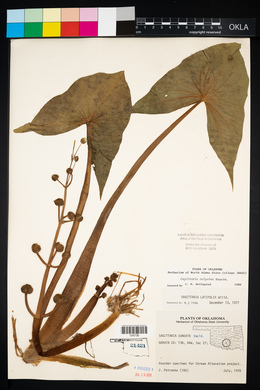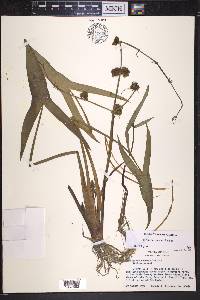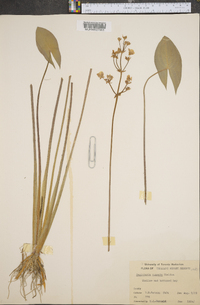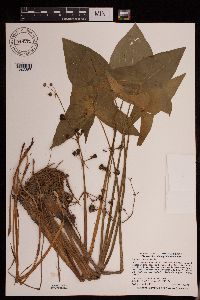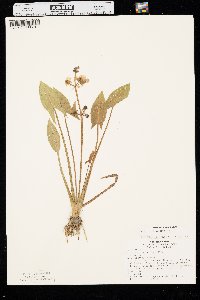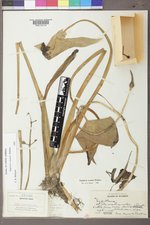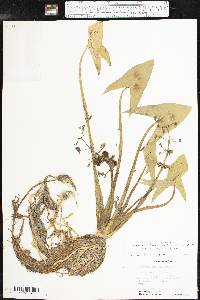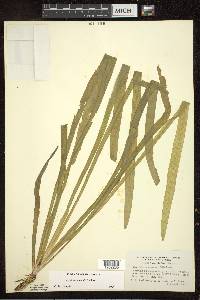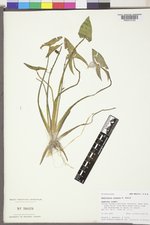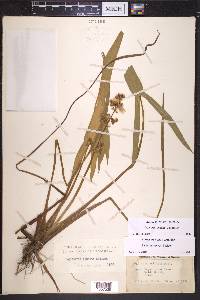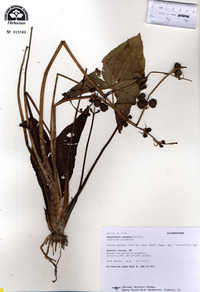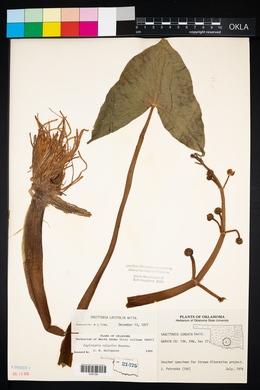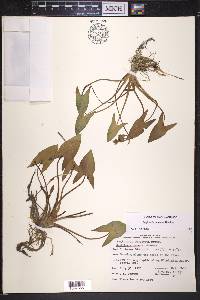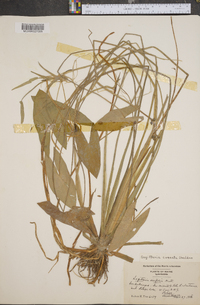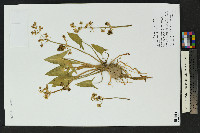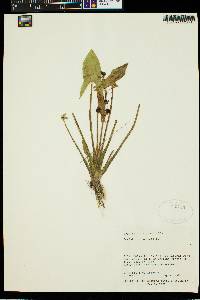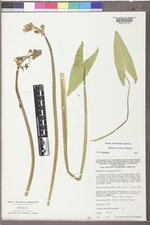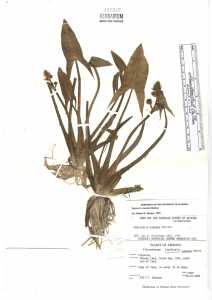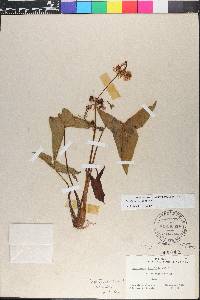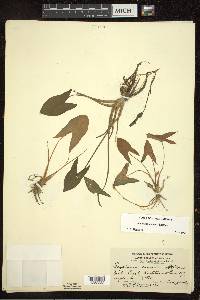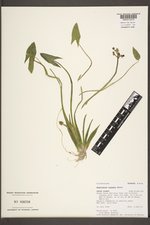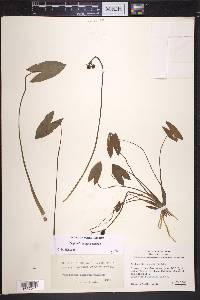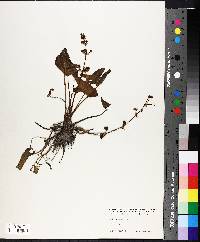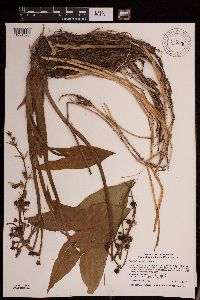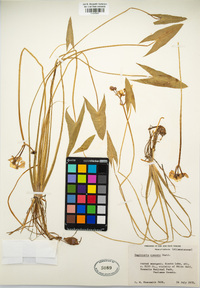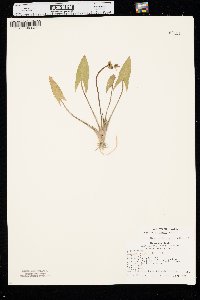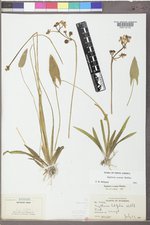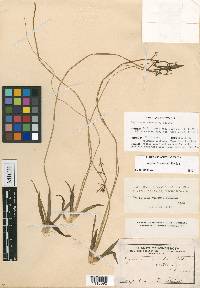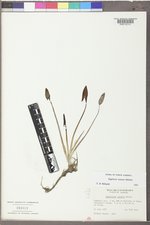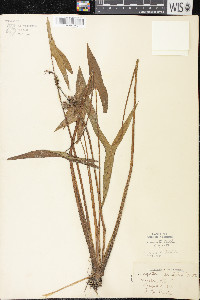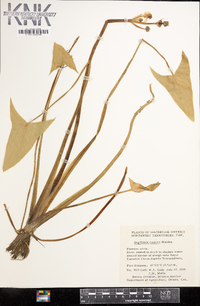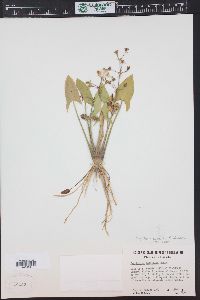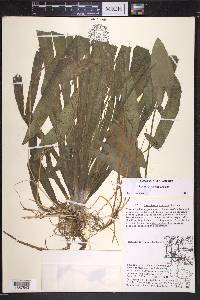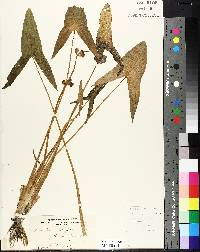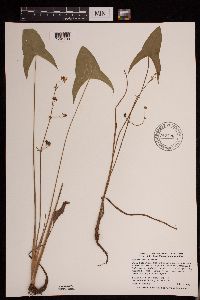Sagittaria cuneata
|
|
|
|
Family: Alismataceae
Arum-Leaf Arrowhead
[Sagittaria arifolia Nutt. ex J.G. Sm., moreSagittaria arifolia var. cuneata (E. Sheld.) Lunell, Sagittaria cuneata f. equiloba Fernald, Sagittaria hebetiloba] |
Herbs, perennial, to 110 cm; rhizomes absent; stolons present; corms present. Leaves emersed, floating, and submersed; submersed phyllodial, flattened, to 45 cm; floating with petiole triangular, to 100 cm, blade cordate or sagittate, rarely linear or ovate, 7.5--9 ´ 3.5--4 cm; emersed with petiole recurved, 3.5--51 cm, blade linear to sagittate, 2.5--17 ´ 1.5--11 cm, basal lobes when present shorter than remainder of blade. Inflorescences racemes, rarely panicles, of 2--10 whorls, emersed, 14--21 ´ 2--10 cm, peduncle triangular, 10--50 cm; bracts connate more than or equal to ¼ total length, lance-attenuate or acute, mostly (4--)7--40 mm, membranous, not papillose; fruiting pedicels ascending, cylindric, 0.5--2 cm. Flowers to 25 mm diam.; sepals recurved, not enclosing flower or fruiting head; filaments not dilated, equal to or longer than anthers, glabrous; pistillate pedicellate, without ring of sterile stamens. Fruiting heads 0.8--1.5 cm diam.; achenes obovoid, abaxially keeled, 1.8--2.6 ´ 1.3--2.5 mm, beaked; face not tuberculate, wings 0--1, ± entire, glands 0--1; beak apical, erect, 0.1--0.4 mm. 2n = 22. Flowering late spring--summer (Jun--Sep). Calcareous and muddy shores and shallow waters of rivers, lakes, ponds, pastures, and ditches, occasional in tidal waters, or in deep flowing water with slow current; 100--2500 m; Alta., B.C., Man., N.B., Nfld. and Labr. (Labr.), N.W.T., N.S., Ont., Que., Sask., Yukon; Alaska, Ariz., Calif., Colo., Conn., Idaho, Ill., Ind., Iowa, Kans., Maine, Mass., Mich., Minn., Mont., Nebr., Nev., N.H., N.J., N.Mex., N.Y., N.Dak., Ohio, Okla., Oreg., Pa., S.Dak., Tex., Utah, Vt., Wash., Wis., Wyo. Sagittaria cuneata is extremely variable. On emersed plants, the leaf petioles are often bent toward the ground. Submersed plants often grow from a basal rosette with a long flexuous petiole and a floating sagittate leave. Plants in deep rivers often develop broad, straplike phyllodia.
Perennial aquatic herb to 1.1 m tall Leaves: emersed, floating, and submersed. Submersed leaves reach 50 cm long and are linear and often ribbon-like. Floating leaves with triangular stalk to 1 m long, 7.5 - 9 cm long, 3.5 - 4 cm wide, lance- to arrowhead-shaped, rarely linear to egg-shaped. Emersed leaves have 3.5 - 51 cm long recurved stalks and are 2.5 - 17 cm long, 1.5 - 11 cm wide, linear to arrowhead shaped, with basal lobes shorter than the rest of the blade. Inflorescence: emersed, singly stalked along a central axis (raceme), rarely with loosely branched stalks (panicle), 14 - 21 cm long, 2 - 10 cm wide, arising from a triangular stalk 10 - 50 cm long, with two to ten whorls of flowers. Flowers: either male or female, found on the same plant (monoecious), to 2.5 cm wide, with sepals 4 - 8 mm long and three white petals 7 - 10 mm long. Male flowers are borne on the upper part of the inflorescence, having smooth filaments equal to or longer than the anthers. Female flowers found lower on the inflorescence, having ascending fruiting stalks 0.5 - 2 cm long and recurved sepals. Fruit: a cluster of achenes 0.8 - 1.5 cm wide. Each achene 1.8 - 2.6 mm long, 1.3 - 2.5 m wide, inversely egg-shaped, with an erect beak 0.1 - 0.4 mm long. Bracts: 1 - 4 cm long, whitish, linear to lance-shaped, pointed, delicate, fused at least one-quarter the length. Similar species: Sagittaria latifolia, Sagittaria brevirostra, Sagittaria cuneata, and Sagittaria montevidensis ssp. calycina all have emersed arrowhead-shaped leaves and filaments lacking scales. Sagittaria latifolia has nearly all emersed leaves that are highly variable (linear to arrowhead-shaped) and achenes with beaks spreading horizontally. Sagittaria brevirostra also has mostly emersed leaves, but they are nearly all arrowhead-shaped. The edges of S. brevirostra achenes are minutely shallow-toothed and the beaks are ascending. Sagittaria montevidensis ssp. calycina has linear submersed leaves, arrowhead-shaped emersed leaves, and achenes with horizontal beaks. While the other species above have separate male and female flowers and reflexed or spreading sepals, S. montevidensis ssp. calycina has male and bisexual flowers. The bisexual flowers are distinguished by a ring of sterile stamens and appressed sepals. Flowering: late June to late August Habitat and ecology: Pond borders, shallow water, and in mud and water of sloughs along waterways. Occurence in the Chicago region: native Etymology: Sagittaria comes from the Latin word sagitta, meaning arrow, referring to the leaf shape. Cuneata means "wedge-shaped." Author: The Morton Arboretum Emersed or submersed, and vegetatively plastic, with large, edible tubers; lvs long-petioled, sagittate to lanceolate or phyllodial, the blade (when emersed) with lanceolate to deltoid-ovate central lobe 10-18 נ1-10 cm and triangular, pointed, usually much shorter basal lobes, commonly (and unlike all our other spp.) cordate when floating; submersed phyllodia, when present, commonly ribbon-shaped, to 5 dm; scape 1-5+ dm, with 2-10 whorls of fls, occasionally branching at the lowest whorl, the upper fls staminate, the lower pistillate, on ascending pedicels 0.5-2 cm; bracts 1-4 cm, lanceolate, acute or acuminate, whitish and delicate; sep ovate, acuminate, 4-8 mm, reflexed in fr; pet 7-10 mm; stamens 15-25, the filaments subulate, glabrous, about as long as the anthers; achenes 1.8-2.6 mm, with a prominent, rounded wing on the back, the ventral wing nearly or quite as large as the dorsal and confluent with the beak, nearly or quite without facial wings, but with resin- ducts; beak very short, erect, 0.1-0.5 mm; 2n=22. Ponds and marshes, in water or mud (often sandy silt); N.S. and Que. to Mack. and Alas., s. to N.Y., n. O., Ill., Okla., Tex., and Calif. July-Sept. (S. arifolia) Gleason, Henry A. & Cronquist, Arthur J. 1991. Manual of vascular plants of northeastern United States and adjacent Canada. lxxv + 910 pp. ©The New York Botanical Garden. All rights reserved. Used by permission. FNA 20014, Heil et al 2013 Duration: Perennial Nativity: Native Lifeform: Forb/Herb General: Aquatic perennial herbs to 40 cm tall (80 cm when submersed), with corms (bulblike underground storage structures) and stolons (runners, or horizontal rooting stems). Leaves: Can be emersed (emerging above the water surface), floating, or submersed; differing in morphology based on position. Submersed leaves are phyllodial (consisting of an expanded petiole and lacking a true blade) and flattened, to 45 cm. Floating leaves have triangular petioles to 100 cm, and cordate or saggitate blades, rarely linear or ovate, to 9 cm. Emersed leaves have recurved petioles to 51 cm, linear to sagittate blades to 17 cm, and when present, the basal lobes are shorter than remainder of blade. Flowers: Inflorescences are verticillate racemes, rarely panicles, of 2-10 whorls per branch, 14-21 cm long, emerging from the water; scapes triangular, 10--50 cm, erect or arching; bracts membranous, connate the bottom 1/4 of their length; flowers to 2.5 cm diam; the lowest whorls in the raceme made up of sessile or short-pediceled pistillate flowers; upper whorls made of staminate flowers on longer pedicels. Sepals 3, recurved, not enclosing flower of fruiting head; petals 3, white, deciduous; stamens numerous. Fruits: Fruiting heads 1 cm diam; achenes obovoid, 2 mm, with a rounded, wide dorsal keel and a recurved beak. Ecology: Found in shallow, stagnant ponds and mud flats; above 5,000 ft (1524 m) in the southwest; Flowers July to August. Distribution: Throughout North America, from New England through the midwest and throughout the west from Ca to AK. Notes: Sagittaria cuneata is extremely variable. On emersed plants, the leaf petioles are often bent toward the ground. Submersed plants often grow from a basal rosette with a long flexuous petiole and a floating sagittate leave. Plants in deep rivers often develop broad, straplike phyllodia. S. longiloba is also found in the southwest; the species can be distinguished by leaf shape. S. longiloba has strongly V-shaped leaves, with the basal lobes twice as long as the linear or lanceolate terminal lobe, while on S. cuneata the basal lobes are equal to or shorter than the terminal lobe. Other species of Sagittaria are present in the Southwest but quite rare. Ethnobotany: Used medicinally by many North American tribes. Also used as food and forage. Etymology: Sagittaria from sagitta, Latin for arrow, referring to the the shape of the leaves; cuneata means wedge-shaped, also referring to the shape of the leaves. Synonyms: Sagittaria arifolia Editor: AHazelton 2015 From Flora of Indiana (1940) by Charles C. Deam All of our specimens are from the lake area where it is local, although there are no reports from the dune area. Found on the muddy or wet, sandy borders of streams, lakes, and ponds and in ditches. ...... Indiana Coefficient of Conservatism: C = 3 Wetland Indicator Status: OBL Diagnostic Traits: emergent leaf blades usually sagittate and seldom >18 cm; bracts acuminate, often >1 cm, connate at base; flower stalks slender; flowers unisexual; sepals reflexed; stamens mostly <15, their filaments glabrous; achene beaks erect, 0.1-0.4 mm. |
|
|
|

